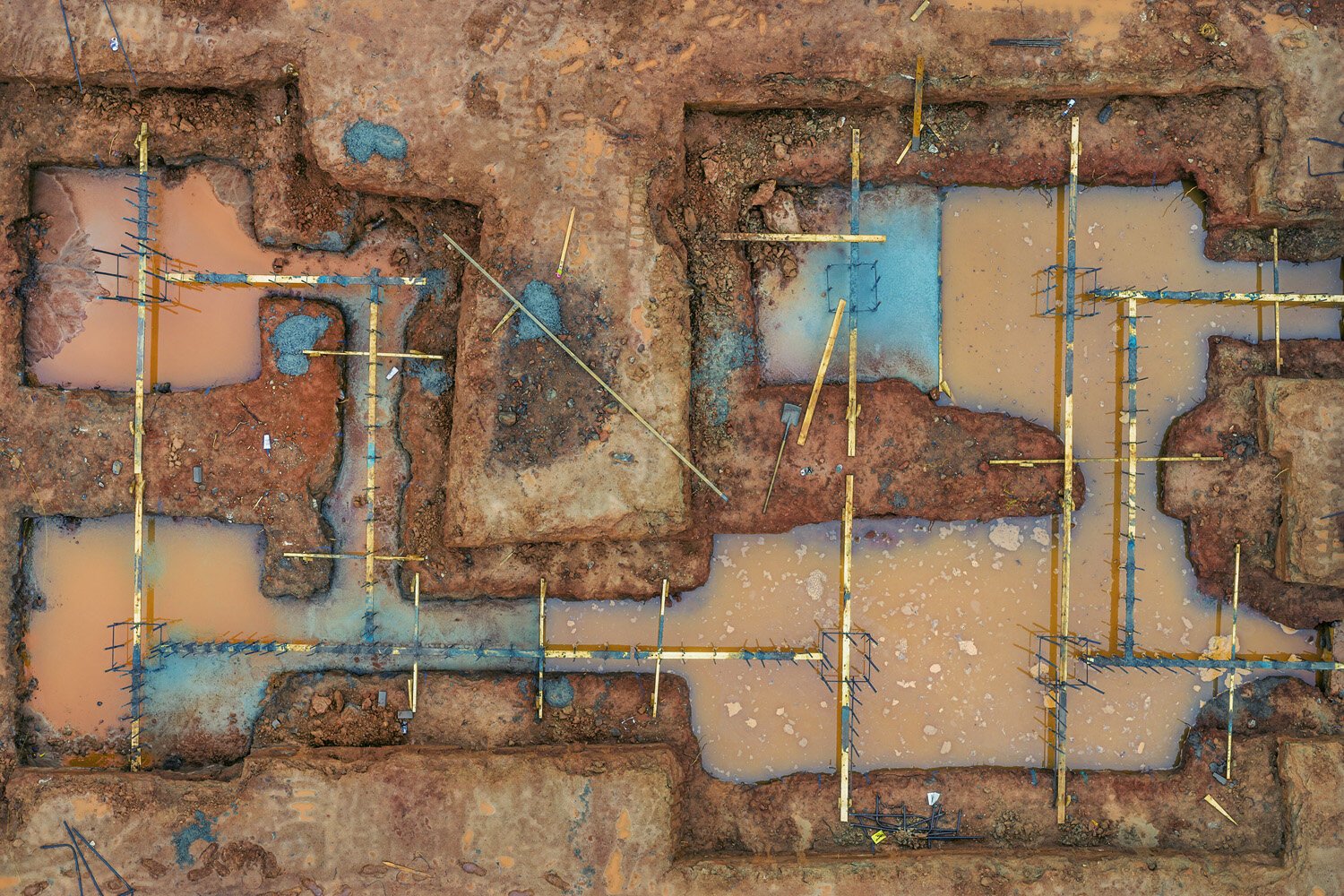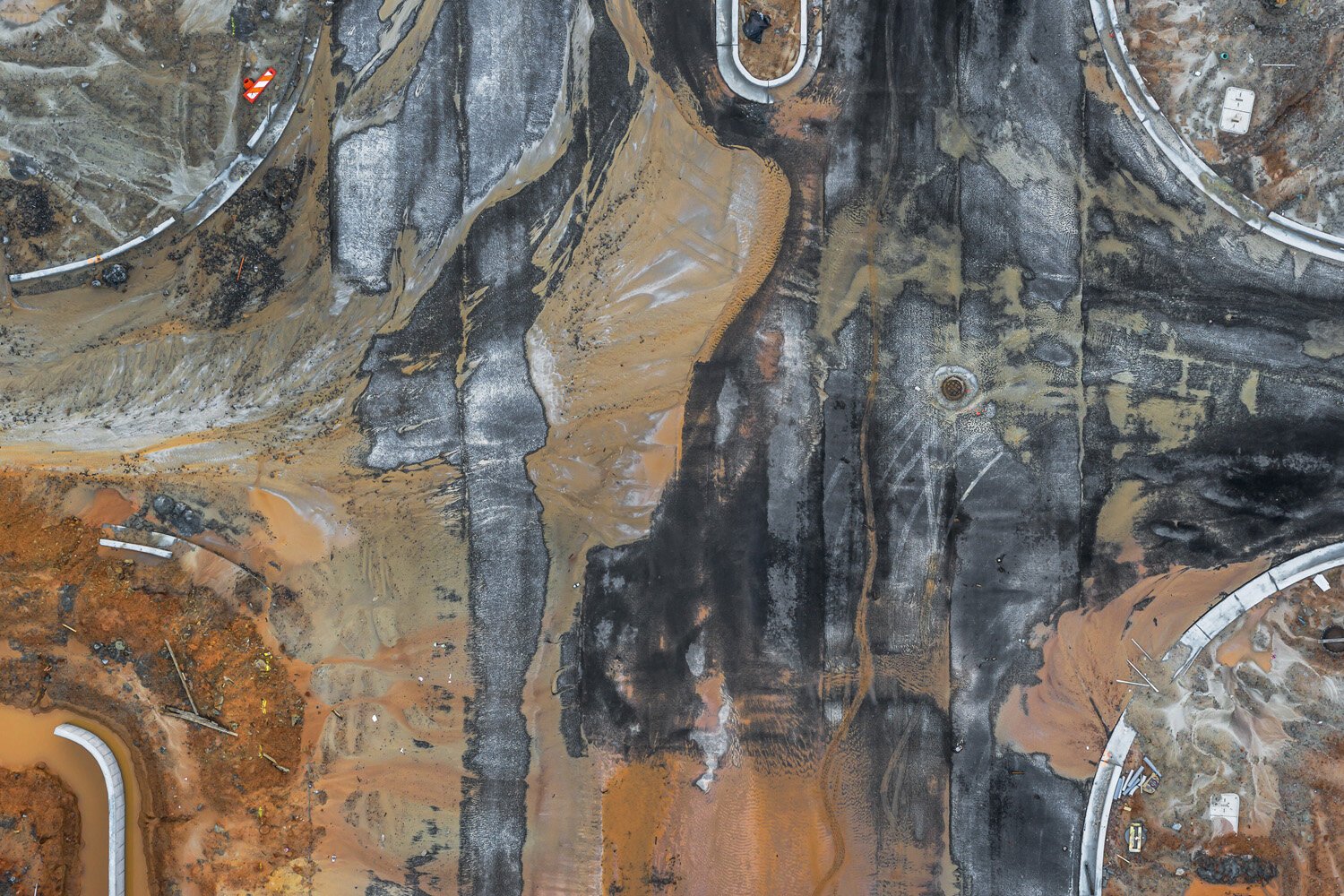The Art of Construction: Peter Essick’s Visual Journey Through Atlanta’s Development
Welcome to this edition of [book spotlight]. Today, we uncover the layers of 'Work In Progress,' by Peter Essick (published by Fall Line Press). We'd love to read your comments below about these insights and ideas behind the artist's work.
Do you have a drone? Have you ever crashed it while trying to photograph something, only to find out you would just be better off taking screenshots from Google Maps? That’s my experience. When I got my DJI drone, I had all sorts of ideas about how I was going to take amazing pictures with it. I took some photos and videos, but I always felt that drone flying was more suited for nature scenery, and I felt limited because I live in a city. That’s why I’m writing this, and not being interviewed as a great aerial photographer…”
Have you ever thought about the beauty hidden in the chaos of construction sites? Peter Essick did, and his fascination led to a stunning photography project captured in his latest book, “Work In Progress.” Over four years, Essick used drone technology to explore and document construction sites around the Atlanta Metro area, revealing the intricate patterns and colors of human-altered landscapes. His aerial photographs offer a unique perspective, transforming everyday scenes of urban development into striking, abstract art.
In this interview, we dive into the creative journey behind “Work In Progress,” uncovering the motivations and challenges Essick faced along the way. From the initial inspiration sparked by a drone project in Fernbank Forest to the complexities of capturing the environmental impacts of construction, Essick shares his insights and experiences. - Martin
Creative Catalyst: What initially inspired you to start documenting construction sites, and how did your approach evolve once you began using a drone.
A few years back, I was working on a commission to photograph Fernbank Forest, an old-growth forest in downtown Atlanta, Georgia. As part of that project, I learned to fly a drone to better document the canopy of the forest. The forest was about a half hour drive from my home, and along the way I noticed many new construction sites. They didn’t look too visually appealing from the street, but I decided to see how they would look from the drone perspective. I really like the graphic nature of the construction sites when seen from the drone perspective, so I kept going with the project.
Aerial Perspective: How has the use of drone technology transformed your perspective on construction sites and their environmental impact? What unique challenges and opportunities does drone photography present compared to traditional methods?
I believe the drone is a great tool for a photographer. Sometimes it is like having a large ladder to be able to see over obstacles. Sometimes it is like being a low-altitude airplane to get a better overview of the landscape. This gives the photographer a better way to document environmental impacts to the landscape.
The first challenge of drone photography is learning to fly the drone. A drone photographer must go through a process of learning how to be a safe drone pilot. There are many places where it is not possible to use a drone, such as near airports or in wilderness areas. Also, one must respect the privacy of people while flying a drone. However, I believe the benefits far outweigh the restrictions.
Visual Aesthetics: Your work captures the textures and colors of human-altered landscapes in a painterly and abstract way. Can you describe your process for finding and composing these visually striking images amidst the chaos of construction?
At a new site, I first fly up to high altitude and look in all directions. Like in traditional photography, I look for a scene that draws me in. Sometimes it is the color, but often it is the graphic nature of a section of the construction. I like to think of construction sites as fast changing landscapes. Often it is the grading or movement of the soil that creates the painterly appearance. A half-built structure often can look more abstract than a finished building.
Environmental Commentary: You mention the environmental impact of construction, such as loss of tree cover and habitat. How do you balance documenting the beauty of these altered landscapes with the need to convey their environmental consequences?
I believe that the beauty of the photos comes from the beauty of the land even in a disturbed state. The photographer Robert Adams has said that the land is able to speak to you even if it has been altered by human activities. Most of the photos don’t show a literal view of loss of tree cover or habitat, but it can be implied. My hope is that if someone takes the time to look through the book the effect on the land will be apparent.
Historical Context: The construction sites you photograph are on the traditional lands of the Muscogee people. How does this historical context influence your work, and what do you hope viewers take away regarding the cultural and historical dimensions of the land?
These truths often get lost in the current debates. The whole city of Atlanta was once an old growth Piedmont Forest on the lands of the Muscogee people. Any attempt at restoration, cultural repatriation or efforts to improve the tree canopy must have this as the base line.
Technological Reflections: Drones are often associated with both creative and destructive purposes. How do you reconcile these dual aspects of drone technology in your photographic practice?
I like to think that any new technology can be used for good or bad purposes. That is why I included the quote from William Gibson that new technologies often end up on the battlefields and in galleries. There are many positive uses of drones for scientific research, agriculture and for visual inspection of infrastructure. Filmmakers have also incorporated the technology into many aspects of their craft.
Continuity of Vision: Your previous project “Fernbank Forest” focused on documenting a pristine natural environment. How did your experiences in Fernbank Forest influence your perspective on the human-altered landscapes in “Work in Progress”?
Throughout my career I have photographed many pristine natural areas and human impacted damaged landscapes. They seem to be the extremes where most locations fit somewhere in between. Construction sites are important because this is where people will ultimately live and work and spend most of their time. It is important from a resource perspective but also for the emotional health of the people who live there for the buildings to be made in a sustainable way. We will always need housing, but with limited resources we must learn to build in a more environmentally friendly way.
Personal Connection: You’ve mentioned the joy and challenge of capturing the perfect moment in an ever-changing landscape. Can you share a memorable experience or a specific moment that stands out to you from this project?
Many of the photographs in the book were made during covid. I found that despite the lockdowns, many construction sites continued to be active. There was one large site that included a golf driving range and many retail spaces and housing units that I went back to regularly during this period. I felt good just to get out of the house and to be able to photograph when so many people were not able to do their regular work.
Future Directions: With the rapid pace of development and technological advancements, how do you foresee your work evolving in the coming years? Are there other subjects or themes you are eager to explore using drone photography?
I recently purchased a new drone, and it has many upgrades that make flying safer and easier. I do have many ideas for future stories using the drone. The ideas all seem to be environmental in nature and using the drone to document some aspect of development. For many years I did environmental stories and almost always incorporated aerial photography into the project. This involved paying for an airplane and helicopter charter which can be quite expensive. It is a joy for me to photograph with a drone at my own pace and without the large expense.
To discover more about this intriguing body of work and how you can acquire your own copy, you can find and purchase the book here. (Fall Line Press,Amazon)
Peter Essick
Peter Essick is an acclaimed photographer and author with a 30-year tenure at National Geographic, focusing on environmental themes. Recognized globally for his impactful work, he aims to showcase the human influence on nature through his art. Essick has produced notable books, including 'The Ansel Adams Wilderness' and 'Fernbank Forest,' and has shifted his recent focus to documenting the changing landscape of his hometown, Atlanta. His works are featured in major collections like the Museum of Contemporary Art of Georgia and are represented by Spalding Nix Gallery in Atlanta. (Website, Instagram)
More photography books?
We'd love to read your comments below, sharing your thoughts and insights on the artist's work. Looking forward to welcoming you back for our next [book spotlight]. See you then!














Peter Essick’s “Work In Progress” uncovers the hidden beauty and complexity of construction sites through the lens of drone photography.
Photography Book Spotlight